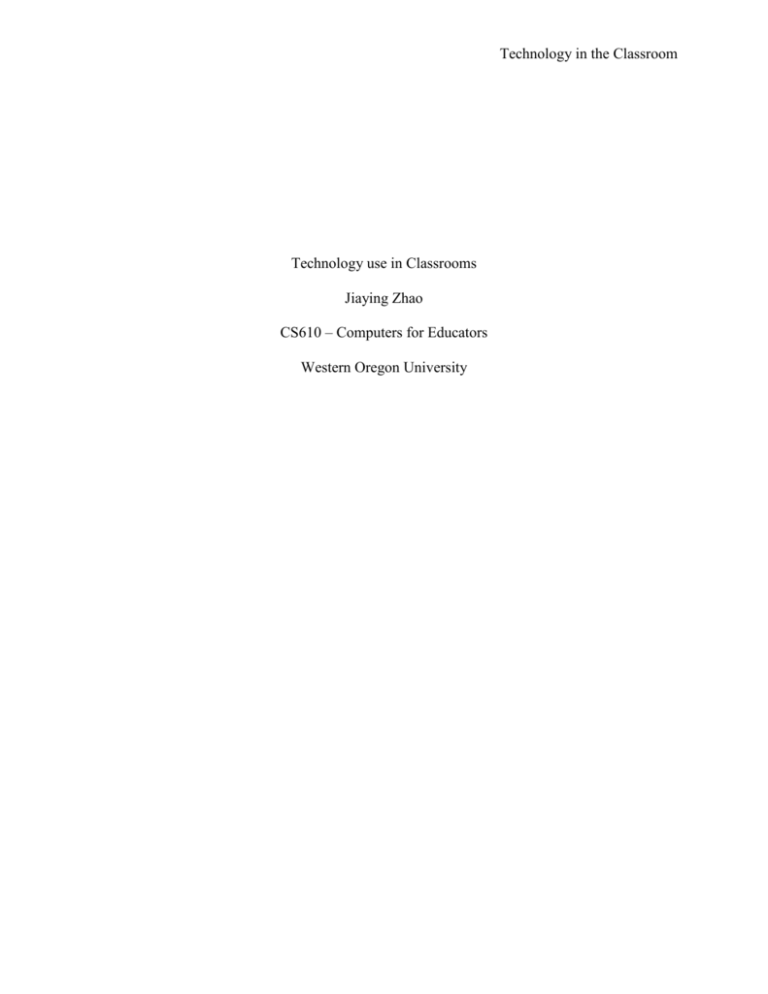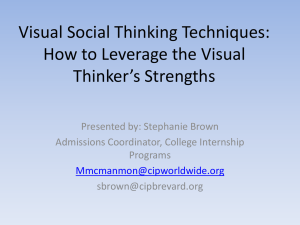Jiaying CSE 610 firstweek
advertisement

Technology in the Classroom Technology use in Classrooms Jiaying Zhao CS610 – Computers for Educators Western Oregon University Technology in the Classroom With the advent of interne technology, computer-based instruction has been widely used in language classrooms. Computer technologies have dramatically changed the way people gather information, conduct research and communicate with others worldwide. Therefore teachers seem to be incorporating technology into their daily lessons more today than in the past. Using technology in the classroom provide more opportunities for both teachers and students. The first article I chose discussed the process of second grade students creating comics on the computer. The second article shared how an EFL teacher developed a program that allowed second language learners to participate in an instructional videoconference with native speakers. The authors assert that computer visuals are always reported in computer-assisted language learning literature, but the reports on the use of comic strip creation tools are very limited. The language aims of using comic strip involved the practice of summarizing, paraphrasing, restating and quoting. Kilickaya and Krajka attempt to explore and examine whether students’ grammar and sentence writing are improved by creating and sharing their own comic strips. 25 Turkish EFL learners will be asked to create a comic strip on a website after teacher introduces a grammar form or function. Kilickaya and Krajka point out that participants express their enjoyment using comic strips, and their grammar and writing are improved through creating their own comic strips. Kilickaya and his colleague also notice that participants are given more opportunities to have more authority over their own learning. Creating their own comic strips allow learners have control over the content of the materials, which makes this kind of computer-based materials is student-centered and enjoyable. Considering the sentences used in the comics, Kilickaya and krajka analyze that students can produce longer utterances than they normally did in their traditional writing; the structures of sentences are more complex in the comic strips than those in the traditional writing. Technology in the Classroom Overall, the authors believe that participants show positive attitudes towards comic strip creation, and the use of electronic comic strip creation in a elementary classroom is helpful to teach grammar and vocabulary. Therefore, the authors agree that comic strip creation should also be integrated into grammar as well as other activities related to reading and writing. Another great article talked about how videoconference instructions via distance technology offer a student-centered active learning. Wu and other authors introduce that the teachers in traditional classroom attempt to shift the focus of the class from lecture and rote learning to active learning through bilingual curricula and technology-assisted teaching. Wu and his colleagues notice that videoconference instructions need to be designed well so that students can connect new knowledge to their own knowledge. The initial presentation should be given by native speakers on some topics, and local teachers scaffold during the videoconferences and they gradually withdraw the support to encourage students to become independent in their interactions. Through the videoconference instructions, the writers indicate that confidence in using English comes from the learners’ ability to understand English conversations, to speak accurate English, and enjoyment. Additionally, ability to understand English conversations is highly related to motivation to learn English. Wu and his colleagues point out English ability is the most important factor showed from instructional videoconferences, while motivation is the indirect factor impacting on learners’ ability and confidence. This student-centered, active learning results in direct correlations of motivation, confidence and ability of students. Wu and other authors imply that some specific conversational training like videoconferences help students develop their English proficiency and motivation. To construct a more effective teaching setting, the teachers’ pedagogical design should employ scaffolding and collaborative learning to make students have effective interactions in the target language. The authors stress that successful Technology in the Classroom communication is a valuable component of an instructional design that builds ability through strengthening motivation and confidence. Technology in the Classroom References Kilickaya, F., & Krajka, J. (2012). Can the use of web-based comic strip creation tool facilitate EFL learners’ grammar and sentence writing? British Journal of Educational Technology, 44(3), 90-94. doi:10.1111/j.1467-8535.2012.01298.x Wu, V., Yen, L., & Marek, M. (2011). Using online EFL interaction to increase confidence, motivation, and ability. Educational Technology & Society, 14(3), 118-129.







